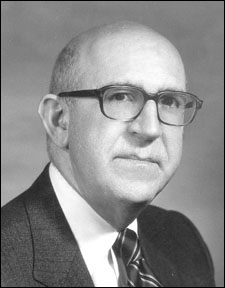Juan Manuel Taveras
Faculty of Medicine – Memorial Minute
Dr. Juan M. Taveras died March 27, 2002, in Santo Domingo, the Dominican Republic, at the age of 83. He was widely regarded as the father of neuroradiology, and pioneered the concept of subspecialization in radiologic practice. He was emeritus Professor of Radiology at Harvard Medical School and emeritus Chair of the Department of Radiology at the Massachusetts General Hospital.

Dr. Taveras was a founder and patron of the subspecialty of neuroradiology. Before Dr. Taveras established the first training program in neuroradiology at Columbia, all neuroradiologic procedures were conducted by neurosurgeons. Dr. Taveras co-authored the first textbook of neuroradiology and is credited with founding both the American Society of Neuroradiology and its journal, serving for several years as its editor.
From 1965 to 1971, he was director of the Mallinckrodt Institute of Radiology and Professor and Chair of the Department of Radiology at the Washington University of St. Louis and the Barnes Hospital. He moved to Boston and Harvard Medical School in 1971 as chairman of the Department of Radiology at the Massachusetts General Hospital. He continued in that position for sixteen years until 1987. Dr. Taveras had a profound impact on the development of radiology during his tenure at MGH. He quickly realized the significance of emerging technologies such as computed tomography, magnetic resonance imaging and interventional radiology, helping to bring them and secure them safely within the boundaries of radiology practice. The department at MGH was organized into organ specialty oriented divisions. This administrative model has been implemented in most academic centers in North America and provides the highest level of clinical care and scientific development. Dr. Taveras always advocated excellence in clinical practice, education and research. He supported research as an essential component of the mission of academic radiology departments, helping to ensure the future of the specialty of radiology. He is credited with training many of our current leaders in both academia and neuroradiology. Dr. Taveras published over 230 scientific papers as well as twelve textbooks, either as first author or co-author, including a five-volume loose-leaf textbook of diagnostic radiology and a seven-volume textbook of general radiology, written in Spanish.
Dr. Taveras was both an influential national and international figure in the field of radiology, travelling and lecturing widely throughout Europe, Latin America and Asia. He was the recipient of gold medals from all four of the major radiologic societies; the Radiological Society of North America, the American Roentgen Ray Society, the American College of Radiology and the Association of University Radiologists. The first endowed chair of radiology at Harvard Medical School was established in Dr. Taveras’ name and the first occupant is the current chair at MGH, James H. Thrall, M.D.
Dr. Taveras always maintained very close ties and a fervent devotion to his country of origin, the Dominican Republic. He recently planned and coordinated the construction of an innovative health care facility in Santo Domingo, which opened last year. This effort was one of his proudest achievements following his retirement from the chair of Radiology. Dr. Taveras was an avid music lover. He played several wind instruments and worked his way through medical school playing clarinet, saxophone, and flute in orchestras and jazz bands. He was also an elegant dancer and a man of great charm. Friends, family and the radiologic community will sorely miss him.
Dr. Taveras leaves his beloved wife Margo, three children, Jeffrey, Louisa and Angela, and six grandchildren.
Respectfully submitted,
Theresa C. McLoud, Chairperson
Joseph T. Ferrucci
R. Gilberto Gonzalez




